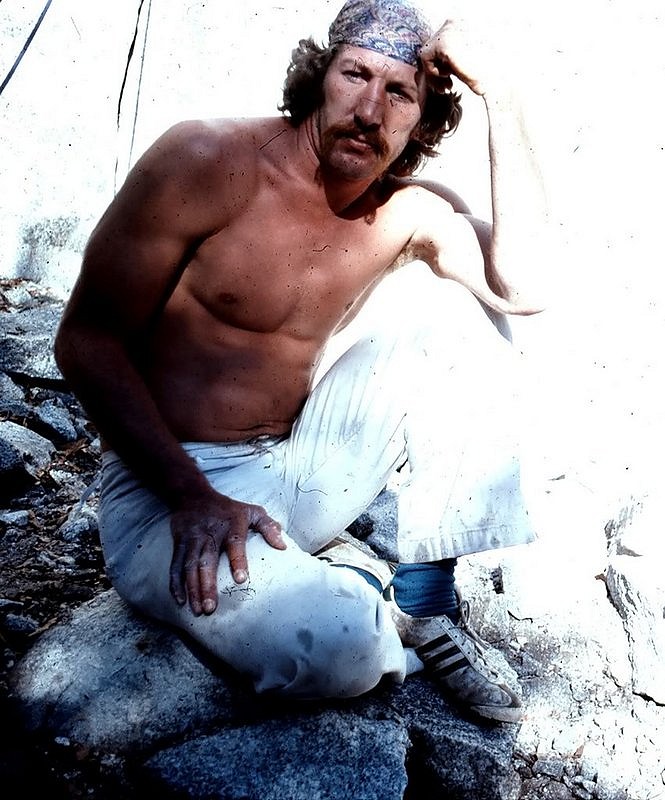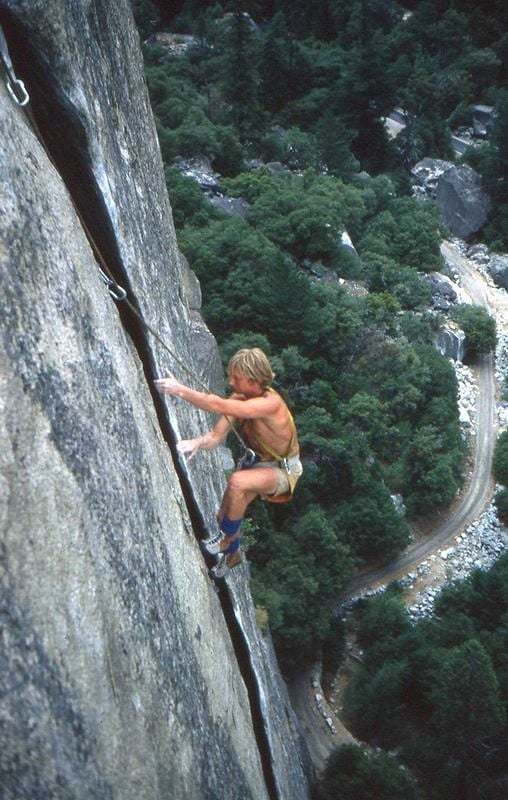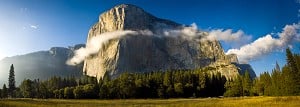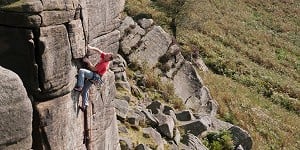
and those at Supertopo.com who helped on this thread, Help..Explaining the YDS Grade especially, Peter Haan, Ed Hartouni, dave, Tami, locker, ilk, bvb, Alan Rubin, Dingus Milktoast....especially Ed for posting this article.
From Ascent, Volume 2 Number 1, July 1973
OPINION
The Innocent, The Ignorant, And The Insecure
The rise or fall of the Yosemite Decimal System

DOWNRATING the difficulty of climbs is an insidious and debilitating practice, but it is not a new game in the climbing world. Its history is long, but it has recently gained new popularity in Yosemite Valley. The reasoning behind downrating varies, but the results are the same, a breakdown of reliability in the basic climbing language.
Practitioners of downrating fall into three main types: the innocent, the ignorant, and the insecure. We are not too concerned with the first because of its rarity. The second can be cured through education. The third is extremely difficult to remedy, as it is based in a fundamental emotional immaturity; its roots are in the instincts of all individuals.
The Yosemite Decimal System (YDS) is founded upon the accepted ratings of individual climbs by the founding fathers of the system. In order to have a system, it is necessary to respect the ratings that form its foundation. Units of time are not changed because some people run the mile faster than others. Chaos would result if everyone's watch had different length minutes. It is not possible to rely on a rating system unless order is maintained within it.

Granted, rating a climb is relatively abstract. Fair rating of a climb implies a moral obligation, on the part of the climber, to consciously be as accurate as possible. A climber who downrates is stating that he is better than another climber. It is a practice as old as the first war. If a climber says a climb is 5.9 that another climber says is 5.10, then the first climber must be better. This is an example of individual competitive climbing.
Group pride, or the pack instinct, exhibits itself when an entire area is downrated. The climbers here are better than the climbers there, because the climbs here are rated harder. Some climbs in certain areas are rated 5.10 or 5.10+ though they have been climbed only once or twice, after innumerable attempts by one of the area's foremost climbers. This could be a gross mistake, or it could be a gross ego-trip.
The most common motivation behind downrating is protection of the downrater's self-image. Avoid the ridicule of having one's climb downrated. Downrate first and be safe. This type of game causes its most dedicated players to fool even themselves. Move rating is an outgrowth of this syndrome. Breaking a pitch into individual moves and rating the pitch by the hardest move is nonsense. A hundred foot lieback with no moves over 5.9, but none under 5.8, and with no place to rest, is not a 5.9 pitch!
At present, 5.10 and 5.11 are the most abused ratings. This is because these are the most prestigious free-climbing categories, and also, because they are the most vulnerable to anatomical idiosyncracies. Since climbers tend to prefer one type of climbing to another, a crack climber, for instance, will be prone to think cracks are less difficult than they, in fact, might be. Practice makes perfect, and easier.
The only fair solution to this problem is a rating based on a comparison of the climbs. Climbs, unlike climbers, don't change much. As a climber progresses in physical conditioning, confidence, and technical proficiency, he may tend to downrate. He should return to establish routes for a rating comparison.
Blatant abuse of the rating system (YDS) was a general practice this past season in Yosemite. It seemed almost "in vogue." Climbs that an individual couldn't do in the spring were 5.8+ by autumn. Other climbs weren't too bad, even though it took several tries, falls, or even a few rests on tension. In a few cases, the climb wasn't "too bad" even though the climber couldn't and didn't do it.
Some people have downrated a climb after their fourth or fifth ascent of it, even though they fell the first time. Once again, practice makes perfect. Personally I do not feel that holders of this attitude are being honest with the climbing community, or with themselves.
Some routes have, in fact, been made easier because of pin scars, broken flakes and fixed pins. The first two situations are permanent and may necessitate a legitimate rating change. Fixed pins on routes of a continuous nature obviously make the route easier. There is a great difference between hanging in a strenuous position to place a pin, and just clipping into a fixed one.
Certain formidable climbs have a history of classic, bold ascents. Fixed pins and the use of new technical gadgetry necessarily reduce the impact of such routes, as compared to more pure and aesthetic ascents. Climbers should feel a moral obligation to maintain the tradition of the first ascent of the route they are doing. This is particularly true of classic routes such as Twilight Zone. The rating of such climbs depends on the style in which it is done, which in turn, determines the mental factor. Doing a climb with a selection of fifteen nuts and no hammer is an entirely different affair than doing the same route with thirty pitons and a hammer.
Following is a list of controversial 5.10 and 5.11 Yosemite climbs. The ratings are in accord with a consensus of those climbers most familiar with the routes. In addition, because of a wide range in the 5.10 category, I have added a sub-letter (a through d) to further classify comparative difficulties. (ff meaning easiest in the class, b more difficult, etc.)
Climbs of more than one 5.10 or 5.11 pitch have been broken down into separate pitches. Pitches are categorized according to the predominate climbing technique used on them. In some cases, two types of technique deserve mention, and the pitch is placed in both categories.
Many problems are inherent in any rating system. Rating, itself, is a problem. The different physiology of climbers presents the main difficulty. A smaller or larger, shorter, longer hand-finger-foot-knee-chest-arm-leg-body will make a huge difference in the comparative difficulty of certain moves or pitches.
Pitches are listed according to general different sizes, but accurate information about absolute sizes of cracks and other pertinent facts can only be had through word of mouth. Climbing is above all else a human endeavor, and precise communication about it can only pass through those who practice it.
Few things are absolute, and rating systems are no exception; but, hopefully, the information given here will help facilitate communication in the climbing community.
Jim Bridwell
HARD FREE CLIMBS COMPARED
FACE CLIMBS
5.10 "A"
Fallen Arches
Maxine's Wall
Angel's Approach
North Buttress, Middle Cathedral
Lichen Nightmare
Pulpit Rock, from the notch
East Buttress, Lower Cathedral
Rixon's West Face, 2nd pitch
5.10 "B"
Pulpit, Orey-Jones route
Perhaps
Limbo Ledge, 1st pitch
Punch Bowl
East Buttress, Middle Cathedral
Henley Quits, 2nd pitch
Peanut
Central Pillar Direct, M.C.R. 8th pitch
5.10 "C"
Mother's Lament
Slab Happy Dihardral
Chain Reaction
Paradise Lost, Middle Cathedral
Cheek
D.N.B., Middle Cathedral
Elusion
5.10"D"
Swan Slab, 1st pitch
Hot Line, 6th pitch
5.11
Calf
Void
CHIMNEYS
5.10 "A"
Hot Line, 5th pitch
5.10"B"
Lost Arrow Chimney
LIEBACKS
5.10 "A"
Twilight Zone, 3rd pitch
La Esquela, 3rd pitch
Rixon's East, 1st pitch
5.10 "B"
Wheat Thin
Basket Case, 4th pitch
Koko Ledge, left side
5.10"C"
Waverly Wafer
Powell-Reed route, Middle Cathedral
5.10"D"
Split Pinnacle
High Pressure
5.11
La Esquela, 1st and 2nd pitches
Hour Glass, left side undercling
THIN CRACKS
5.10 "A"
Stone Groove
Swan Slab, 2nd pitch
New Dimensions, 2nd & 3rd pitches
Vendetta
Sacherer Cracker
Siberian S.S.
East Corner of Higher Spire
Ramp of Deception
Central Pillar Direct, M.C.R. pitches 2 & 6
5.10 "B"
Outer Limits, 1st pitch
Gripper
Anathema
Easy Streaks
Rixon's East, variation on 1st pitch
Bare Necessities
New Dimensions, 1st pitch
5.10 "C"
Outer Limits, 2nd pitch
Lunatic Fringe
Hardly Pinnacle
High Quality
Slack Center
English Breakfast
Sacherer-Fredericks route. Middle Cathedral
Limbo Ledge, 2nd pitch
Hot Line, 1st and 2nd pitches
Mental Block, 1st pitch
5.10 "D"
Catchy
Vanishing Point
Serenity Crack
Olga's Trick
Five and Dime
Independence Pinnacle, Center route, pitch 3
Leaning Meanie
5.11
New Directions
Butterfingers
Abstract Corner
HAND-AND-FIST, 1" TO 4"
5.10 "A"
Henley Quits
Midterm
Ahab
Hump
Absolutely Free, right side
Secret Storm
5.10"B"
Peter Pan, right side 2nd pitch
Book of Job
Independence Pinnacle, Independent route, pitch 2
Quickie Quizzes
Rixon's West Face, 5th pitch
This and That, 2nd pitch
5.10 "C"
Meat Grinder
Bridalveil East, the Midget Chimney
Straight Error, 2nd pitch
5.10 "D"
1096
Final Exam
5.11
Short Cake
Gold Rush
OFF-WIDTH CRACKS, 4" & BIGGER
5.10 "A"
Penny Nickle Arete
Reed Pinnacle, left side
Girl Next Door
Crack of Despair
Crack of Doom
The Cookie, left side
Peter Pan, right side, 1st pitch
Chingando
5.10 "B"
Henley Quits, left side
Vendetta, 2nd pitch
Leverage
Hourglass, right side
Edge of Night
Slack, left side
Pulpit Pooper
Narrow Escape
Tower of Geek
Kat Pinnacle
Independence Pinnacle, Independent route, pitch 3
5.10 "C"
This and That, 1st pitch
Forbidden Pinnacle
Hourglass, left side
Chopper Flake
Jam Session
5.10"D"
Mental Block, 2nd and 3rd pitches
Twilight Zone
Steppin Out
Fall Out
5.11
Cream
Basket Case
















Comments